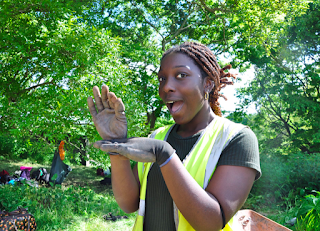What is the purpose of porpoise? New Berkeley discoveries
Last week, two of our students, Nkiruka Ogbogbo and Anneke Schadenberg, were busy sieving through spoil from Trench 8, when they happened upon not one, but two bone discs, known as epiphyses, which are believed to be from the tail of a young porpoise. These finds came from the backfill of a wall construction or robbing cut and are a first here at Berkeley – everyone on site is very excited by the find!
 |
| Anneke and her find |
Although porpoise is not something commonly found on menus today, various archaeological and historical records suggest that it was eaten in the past. Marine resources have long been an important part of human subsistence, with some of the earliest evidence of porpoise exploitation having been found at West Voe, a remote Mesolithic site in the Shetland Islands (Buckley et al. 2013). Evidence for porpoise exploitation has also been found in association with the Saxon period, during which the consumption of marine food became more and more prevalent.
Records detail that the Saxon Tidenham Estate, situated just across the Severn estuary from Berkeley, received numerous porpoises in food rents – presumably sourced from the estuary itself, which was also quite possibly the source of our own porpoise remains. Porpoise bones have also been found in assemblages from Medieval religious houses, and porpoise meat is believed to have been a reasonably common aristocratic dish towards the end of the Medieval period, and into Post-Medieval times (Holmes 2017). Therefore, our finds could easily belong to either period as they were retrieved from post-Norman robbing of a Late Saxon wall, built over an infilled earlier Saxon ditch.
 |
| Porpoise illustration https://www.acsonline.org/harbor-porpoise? |
Archaeologists and historians are fairly settled on the idea that porpoises were used to provide past societies with food, blubber, hide, and various other tool-making materials, but a longstanding debate still surrounds whether they, and indeed other members of the cetacean family, were actively hunted or whether they were only used if and when they became stranded on shore. While it has been noted that Saxon fishermen regarded large whales as too dangerous to catch, it is not clear if the same sentiment stood for porpoises. The Medieval period saw a surge in the number of aristocrats laying claim to various stranded marine animals, but again it is not clear if they were ever actively sought out and hunted (Holmes 2017).
Debate surrounding the methods of acquisition of marine mammals by past peoples is only made more complicated by the difficulty with which their remains are identified. Comparative morphology techniques have been widely used to allow archaeologists to classify cetacean bones, but these often require a great deal of knowledge and skill to be carried out properly and can be unreliable - especially when remains are morphologically ambiguous. DNA sequencing is another method by which remains can be identified, but this is relatively time-consuming and expensive (Buckley et al. 2013).
More recent research has drawn attention to a process called Zooarchaeology by Mass Spectrometry (otherwise known as ZooMS), which is believed to be both more reliable than comparative morphology and more efficient than DNA sequencing (Buckley et al. 2013). Though this itself is a relatively destructive technique, various studies have shown that it is proficient in providing identification to the subfamily level, allowing it to distinguish a wide range of marine mammal species. Therefore, although we are fairly certain that our bones are that of a porpoise, it would only be with further testing that we could be absolutely sure.
 |
| Close-up of the porpoise vertebrae segments |
These wonderful finds have presented to us all sorts of interesting ideas and questions, not all of which we know the answers to yet. Whilst it is not clear whether the bone belonged to the Saxon or Medieval period, it is also not yet clear whether it was left as food, as oil processing waste, or whether it may have had another purpose. The fact that no other, larger porpoise bones have been found nearby could indicate that the vertebrae pieces were on site as traded “artefacts” and may have even been used as gaming counters. Regardless, they provide us with an exciting insight into the historical biogeography of porpoises as well as the ecological conditions of the past.
We are now eagerly awaiting further analysis of the vertebrae pieces by our brilliant post-excavation team back in Bristol. We are extremely thankful to Professor Jacqui Mulville and Dr Julia Best of Cardiff University, for their assistance in identifying the finds, and we also give special thanks to Dr Fay Worley of Historic England who has been incredibly helpful in allowing us to understand more about the archaeology of porpoises and the zooarchaeological processes that allow us to classify them.
Elsa Mendl and Grace Wright
Buckley, M., Fraser, S., Herman, J., Melton, N.D., Mulville, J., Pálsdóttir, A.H. (2013). Species identification of archaeological marine mammals using collagen fingerprinting. Journal of Archaeological Science, [online] vol. 41, p. 631-631. Available at: https://www.sciencedirect.com/science/article/pii/S0305440313003105
Holmes, M. (2017). Southern England: A Review Of Animal Remains From Saxon, Medieval And Post-Medieval Archaeological Sites. [pdf] Historic England. Available at: https://research.historicengland.org.uk/Report.aspx?i=15561&ru=%2fResults.aspx%3fp%3d1%26n%3d10%26a%3d5172%26ns%3d1

Been using this for a while now 👉👉👉 Crypto Market Monitor – very helpful for basic TA.
ReplyDelete